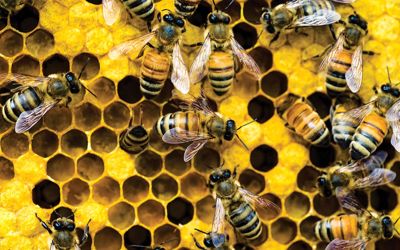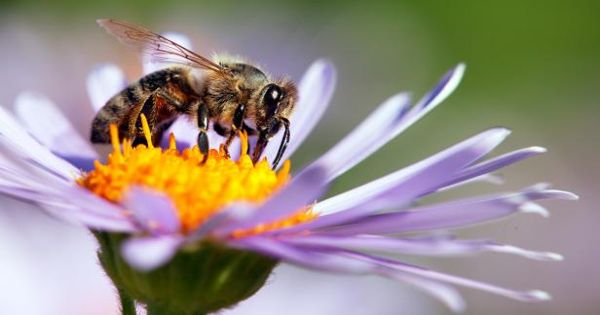Researchers at the University of Michigan nestled and captured more than 4,000 bees of 60 species. Bees were gathered in winter squash farms around Michigan, where both maintained honeybee colonies and wild native bees pollinate squash flowers. All but one species—Apis mellifera, the common European honeybee—are native bees. The number of bee species present in each farm ranged from 7 to 49.
A new analysis of thousands of native and nonnative Michigan bees shows that the most diverse bee communities have the lowest levels of three common viral pathogens.
Consistently, lower levels of viruses were closely linked to increased species richness in local bee populations. The research was published online on Feb. 11 in the journal Ecology. “This result is exciting because it suggests that promoting diverse bee communities can be a win-win strategy to simultaneously reduce viral infections in managed bee colonies while helping to maintain native bee biodiversity,” said Michelle Fearon, a researcher at the University of Michigan, Department of Ecology and Evolutionary Biology.
“In the light of the recent decline in the global pollinator population due in part to the spread of pathogens, these results offer the hope that conservation efforts could also benefit pollinator health more broadly,” said Fearon, who conducted her doctoral dissertation research. She is now undertaking a follow-up analysis that investigates how natural areas keep pollinator populations safe.

The Ecology research is the first to demonstrate that high levels of biodiversity in bee populations can help to dilute the adverse effects of viral pathogens. Help for this “dilution effect” has been identified in other host-pathogenic processes – such as tick-borne Lyme disease – but this is the first time it has been seen for pollinator viruses. However, the notion of dilution effects remains contentious among ecologists.
Fearon and her collaborators collected 4,349 bees in 14 winter squash farms in Michigan over two summers. Michigan winter squash contains acorn squash, butternut squash, spaghetti squash and pumpkins.
Honeybees were observed at both locations and a wide variety of native bees were also present in squash fields and along the edges of the field. In reality, native pollinators have become much more frequent visitors to squash flowers than honeybees in most areas.
Four forms of bees – European honeybees, Eastern bumblebees (Bombus impatiens), squash bees (Eucera pruinosa) and several species of sweat bees (Lasioglossum genus) – were the most common species of the bee populations sampled. These four classes were tested for the existence of three viruses that usually infect handled honeybee colonies: the deformed wing virus, the black queen cell virus, and the sacbrood virus.
These diseases lead to a high rate of colony mortality among honeybees, and there are no readily available drugs that beekeepers can use to manage them. Previous experiments have suggested that native bees are less often infected and may be less likely to spread viruses to other bees.
The virus spreads as the bees travel from flower to flower, collect pollen and nectar and pollinate the plants. The use of virus-contaminated pollen is suspected to be the primary mode of transmission. For each of the four focus bee classes in the U-M sample, researchers observed that lower virus prevalence was closely related to increased biodiversity in the local bee community: the more bee species present, the lower the proportion of infected bees.
The virus spreads as the bees travel from flower to flower, collect pollen and nectar and pollinate the plants. The use of virus-contaminated pollen is suspected to be the primary mode of transmission. For each of the four focus bee classes in the U-M sample, researchers observed that lower virus prevalence was closely related to increased biodiversity in the local bee community: the more bee species present, the lower the proportion of infected bees.
“So, bees from pollinator communities with many species are less likely to get sick because they share flowers with many bee species that are less likely to spread the virus, while bees from honeybee-dominated communities are more likely to share flowers with honeybees that are good at spreading the virus,” Tibbetts said.
Bees are indispensable pollinators, fostering both agricultural productivity and the diversity of flowering plants worldwide. In recent decades, both wild bees and controlled honeybee colonies have seen population losses due to numerous interactive causes, including habitat destruction, parasites and disease, and pesticide use.
“We have found encouraging evidence that the conservation efforts of pollinators can generally benefit the health of both managed honeybee colonies and native bees,” Fearon said. “This management strategy could be particularly crucial in agricultural areas where honeybees and native bees visit crop flowers—places that may be hot spots for viral transmission among bee species.”















